Ann Carroll Fitzhugh facts for kids
Ann Carroll Smith (1805–1875) was an important American woman who fought against slavery. She was married to Gerrit Smith, who was also a well-known abolitionist. Ann was the mother of Elizabeth Smith Miller. Her older brother was Henry Fitzhugh.
Ann and Gerrit Smith lived in Peterboro, New York. Their home was a secret stop on the Underground Railroad. This was a network of safe houses that helped enslaved people escape to freedom. Ann, also known as "Nancy," often let her special carriage be used to hide and transport people escaping slavery to Canada.
In 1822, Ann Fitzhugh, who lived in Rochester, New York, married Gerrit Smith. She was a very religious person. Her strong beliefs helped shape her husband's views on social fairness and ending slavery.
Fighting Against Slavery
The Smith family home was a busy place. It hosted many meetings for people who wanted to end slavery. It also held early meetings for women's rights before the American Civil War.
When Ann was a child in Chewsville, near Hagerstown, Maryland, she was given an enslaved person named Harriet Sims. Harriet was later sold and taken to Kentucky with her husband, Samuel Russell. Ann and Gerrit found the Russells. In 1841, they bought their freedom and helped them settle in Peterboro.
The Smiths fully joined the movement to end slavery in October 1835. This happened after a meeting of the New York State Anti-Slavery Society in Utica, New York, was broken up by people who supported slavery. Ann and Gerrit stepped in. They offered their Peterboro mansion as a safe place for the meeting to continue. No one else offered help. The crowd was too big for their house, so the meeting moved to the largest building in Peterboro, the Presbyterian Church.
While Ann's daughter Elizabeth went to a Quaker school in Philadelphia, Ann stayed in the city for long periods in 1836-37 and 1839. During these visits, Ann met other abolitionists like Lucretia and James Mott, C.C. Burleigh, and Mary Grew. Ann and her daughter also taught Sunday school in an African-American community in Philadelphia.
Life at the Smith Home
Ann was seventeen when she married Gerrit Smith. Historians say that Ann brought happiness and peace to their home. She and Gerrit had a very loving marriage. Gerrit once said, "Heaven has broke loose!" when Ann walked into a room.
The Smiths lived in a large house in Peterboro. It faced the village green. Their home had a big central hallway. On one side were the library, dining room, and kitchen. On the other side were a parlor and a conservatory. The Smiths believed in equality, simplicity, learning, and spirituality in their daily lives. After 1835, they supported the free-produce movement. This meant they would not serve food that was grown using enslaved labor.
In the 1830s, the Smiths changed some of their religious views. They started exploring new Christian beliefs. This led them to create "free churches" in Oswego and Peterboro, New York, in 1839 and 1843.
Ann's Family Background
Ann Fitzhugh Smith was the daughter of Colonel William Frisby Fitzhugh. He owned a place called "The Hive" in Chewsville, Maryland, near Hagerstown, Maryland. William Fitzhugh, along with Nathaniel Rochester and Charles Carroll, bought land at the Genesee Falls. This area later became Rochester, New York.
Ann's father, Colonel William Fitzhugh (1761–1839), was born in Calvert County, Maryland. Ann's mother, Ann Hughes (1771–1828), was the daughter of Daniel Hughes, who owned an iron business. Ann Hughes married Colonel William in 1789. The Fitzhughs and Hughes families attended Saint John's Episcopal Church in Hagerstown. A special window in the church was given in memory of Ann Fitzhugh's mother.
Ann and Gerrit Smith were usually financially stable. However, after the Panic of 1837 (a big economic downturn), they faced some difficulties. They moved from their large Peterboro mansion to a smaller cottage. Both Ann and her daughter, Elizabeth, worked in Gerrit Smith's land office to save money.
Ann and Gerrit Smith joined the Peterboro Presbyterian Church in 1826. They had seven children, but five of them died young. Ann's surviving children were Elizabeth, who was the mother of Gerrit Smith Miller, and Greene (1842–1886).
Later Years
Gerrit Smith passed away in 1874 while he was in New York City. Ann returned to their home in Peterboro after taking care of family matters. She passed away in 1875.


